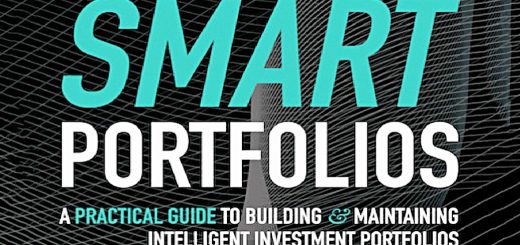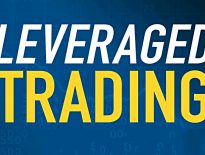Leveraged Trading 2 – Trading Systems

Today’s post is our second visit to a new book by Rob Carver, one of our favourite financial authors. The book is called Leveraged Trading.
Contents
Trading Systems
In Chapter Three, Rob introduces us to trading systems.
He says that a trading system has three jobs: (( He actually said two, but I think three is a better fit ))
- When to open a new position
- This usually means buy, but would mean sell for a short.
- Deciding the size of the position
- This is to do with risk and money management
- When to close a position (its duration)
- Usually, this means to sell, but with shorts, it means to buyback
- Selling is harder for humans than buying is
Rob summarises the advantages of using a system:
- It will allow you to overcome human emotional and behavioural biases.
- Put simply, systems make better forecasts than humans.
- Systems can also exploit these biases in others.
- Systems will have been back-tested against historical data.
- The same rules can be applied to many instruments, allowing for easy diversification.
- And systems can be automated if you so desire.
He also runs through the common objections to using a system, but most of them don’t hold water.
One valid criticism is that systems can’t adapt when markets change.
- Rob’s solution is to use systems whose source of return has persisted for a very long time.
It’s also true that systematic investing is boring (if you are doing it properly).
- But investment isn’t supposed to be fun – it’s meant to be profitable.
Rob also warns against trading systems from “expert advisers”.
- And against copy trading, because the websites involved use poor scoring methods that can be easily gamed.
Trading concepts
In Chapter Four, Rob explains some basic trading concepts.
Here’s what you need to be familiar with:
- An instrument or product – dated or undated
- A trading rule, including position sizing and stop-loss rules
- Capital
- Home currency and instrument currency
- Standard deviation and gaussian normal distribution
- Note that annual SDs are 16 times the daily SD
- The S&P 500 has an annual SD of 16%, and a daikly SD of 1%
- Annual risk = (notional) exposure * annual SD
- Risk-adjusted returns, as measured by the Sharpe ratio
- Risk targets, measured as an annual SD
- Minimum trade size and incremental trade size, the minimum required capital
- Risk-adjusted costs (RAC) – costs as a proportion of your risk target
- For example, 1.5% costs with a risk target of 15% equals 10% RAC
- This measure of costs is unaffected by leverage
- It also shows how much your SR will be reduced by – 10% RAC will reduce your SR by 0.10
- Annual costs, from holding costs and transaction costs
- Risk-adjusted holding cost = holding cost / instrument risk
- This measure is unaffected by leverage
- Risk-adjusted per transaction cost = transaction cost / instrument risk
- Risk-adjusted annual transaction cost = transaction cost/instrument risk * number of trades per year
- Total RAC = RA annual transaction costs + RA holding costs
The Starter System
Chapter Five introduces Rob’s Starter System (we’ll abbreviate this to RSS for obvious reasons).
The RSS:
- trades a single instrument via a single product
- uses one rule to open a position
- a second rule to calculate the size of the position
- and a third rule to decide when to close a position
To decide which instrument to trade, Rob works out the SR for a wide range of instruments using the RSS.
- The average SR is 0.24, but there is a wide spread (from 1.5 to -0.5)
- The best SRs are shown by Italian and French bonds.
But when the one- and two-SD error bars are added to the plot, it’s clear that it’s impossible to say with any certainty which instruments have performed better than others.
- There just isn’t enough data to decide.
Rob recommends ignoring pre-cost returns when deciding which instrument to trade.
Costs
The correct approach is to use the instrument and products with the lowest costs.
- Unfortunately, these often require the most capital, and so are not available to all traders.
Rob limits his costs to one-third of his expected returns.
- This acts as a speed limit on trading.
When expressed in risk-adjusted terms, this means that the “speed limit” is equal to one-third of the SR.
- The RSS has an SR of 0.24, so risk-adjusted costs (RAC) should be no more than 0.08, or 8%.
In practice, Rob aims for 5% – but he uses relatively cheap futures.
- These have a RAC of 1%, but require £40K of capital.
DFB spread bets require only £2.6K of capital, but cost 11%.
- Quarterly spread bets (and those on FX or index futures) between 2% and 6% (lower than the speed limit).
Undated products are more expensive than their dated equivalents.
Tax
Rob plays down the significance of tax to most traders.
- The RSS is only expected to make 5% a year, and we each have an annual CGT allowance of 12K.
So you would need to be trading £250K to run into problems.
- If that’s the case, you might prefer to use spread bets.
Rob calculates the break even point where spread bets beat cheaper (but taxable) futures as being £340K.
Opening
Rob likes trading rules to be:
- objective
- simple
- explainable
- to provide intuitive signals
- and of course, to have a profitable back-test
The RSS uses a momentum rule – a moving average crossover.
- Note that this rule can also be used to close positions.
The values of the fast and slow MAs are chosen not only according to returns.
- Rob also wants to target a given amount of trading each year.
He uses a fixed ratio of 4 between fast and slow (eg. 16 days and 64 days) to investigate.
- My favourite pair is 50 and 200, which also has a ratio of 4.
Rob says that any ratio between 2 and 6 is fine.
- Rob’s analysis shows that 64/256 produces the best SR, but anything from 8/32 upwards is fine.
Faster crossovers lead to more trades and higher costs.
- 8/32 is the fastest pair with costs below the speed limit.
- 8/32 generates 9 trades a year on average.
Rob chooses 16/64 as the pair he will use.
- This generates 5.4 trades per year on average.
For many instruments, longer pairs will have a performance too similar to buy-and-hold.
- Very volatile stocks might be the exception to this.
Rob also feels that the excessive boredom produced by rules that lead to very few trades can lead to problems.
Position sizing
Position sizing is a two-stage process:
- Work out your target exposure (in £)
- Translate that to units of your chosen instrument/product.
Target exposure = target risk % * capital / instrument risk
So if you have £10K in your account and a 12% risk target, in order to trade the S%P 500, which has a 16% annual risk, the calculation is:
Exposure = 12% * 10,000 / 16% = £7,500
This translates to a leverage factor of 0.75 (£7.5K / £10K).
Risk targets
Rob also calculates a maximum prudent risk target by looking at maximum losses.
The S&P once crashed 25% in a day (October 1987).
- If your maximum bearable loss is 33.3%, then the prudent leverage is 33.3%/25% = 1.33
So your maximum prudent risk target is 1.333 * 16% (S&P annual risk) = 21.3%
Rob recommends a risk target for the RSS of 12%.
- At 24%, you have a 1 in 4 chance of an annual 10% loss, and a 1 in 6 chance of an annual 20% loss.
Rob himself uses a 24% target, based on his personal appetite for risk.
- This is also the optimal risk target from the Kelly analysis, given that the RSS has an SR of 0.24.
- Which means that a 24% target would make the most money in the long run.
But most traders use a conservative target of “half-Kelly”.
- This takes into account uncertainty and trading costs.
And gets us back to a 12% risk target.
- Rob notes that most hedge funds target between 10% and 20% risk and their systems are much better than the RSS.
Conclusions
We’ll leave it there for today.
- We’ve covered another one-sixth of the book, so we’re still on track to finish in another four articles (plus a summary).
The pace picked up today, and we’re into the meat of the basic system.
- In the next article, we’ll finish off the system rules, and take a look at how it trades.
Until next time.















